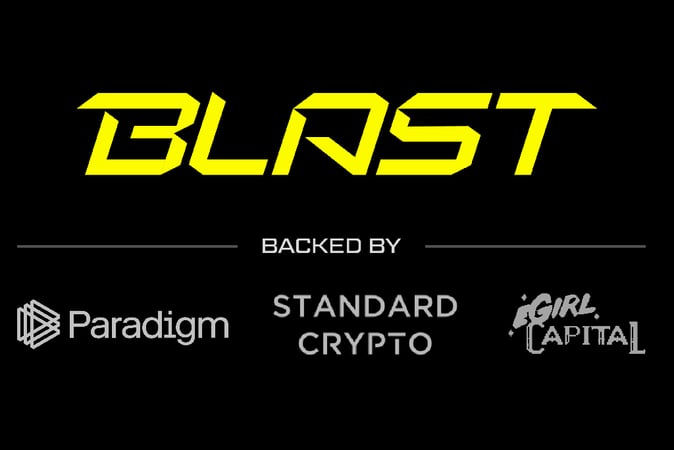The cryptocurrency world is buzzing with excitement as Paradigm, a leading crypto-focused venture capital firm, has invested $20 million in Blast, an innovative Ethereum Layer 2 (L2) protocol. This significant funding round, announced in November 2023, marks a pivotal moment for Blast, a project aiming to redefine how users interact with Ethereum by offering native yield on ETH and stablecoins. With the backing of Paradigm and other prominent investors, Blast is poised to make waves in the decentralized finance (DeFi) space. In this article, we’ll dive into what Blast is, why Paradigm’s investment matters, and how this development could shape the future of Ethereum’s scalability and DeFi adoption.
What Is Blast? An Overview of the Ethereum Layer 2 Protocol
Blast is an Ethereum Layer 2 solution designed to address the blockchain’s well-known challenges, including high transaction costs and slow processing speeds. Unlike traditional L2 networks, Blast stands out by offering native yield for both Ethereum (ETH) and stablecoins, a feature that sets it apart from competitors like Optimism and Arbitrum. This means users can earn returns on their assets automatically, without needing to actively stake or manage their holdings.
Founded by Tieshun Roquerre, also known as Pacman, the creator of the successful NFT marketplace Blur, Blast operates as an optimistic rollup. This technology processes transactions off-chain to reduce congestion on Ethereum’s mainnet, then batches them for final settlement on the Layer 1 blockchain. By leveraging Ethereum staking through Lido and stablecoin yields via MakerDAO’s Dai Savings Rate, Blast offers users approximately 4% yield on ETH and 5% on stablecoins, alongside additional rewards in the form of Blast Points. These points, redeemable in May 2024, have fueled early adoption, with over $30 million in assets bridged to the platform within hours of its launch.
Why Layer 2 Solutions Are Critical for Ethereum
Ethereum remains the backbone of DeFi and Web3, but its scalability limitations have long been a hurdle. High gas fees and slow transaction times can deter users, especially during periods of network congestion. Layer 2 solutions like Blast aim to solve these issues by processing transactions more efficiently while maintaining Ethereum’s security and decentralization.
Blast’s unique approach—combining native yield with an optimistic rollup framework—makes it particularly appealing for DeFi investors and developers. By reducing transaction costs and offering passive income opportunities, Blast could attract a new wave of users to Ethereum’s ecosystem, further solidifying its position as the leading smart contract platform.
Paradigm’s $20M Investment: A Vote of Confidence in Blast
Paradigm, a research-driven investment firm known for backing innovative crypto projects, led Blast’s $20 million funding round, with participation from Standard Crypto, eGirl Capital, Mechanism Capital’s Andrew Kang, Lido’s strategic advisor Hasu, The Block’s CEO Larry Cermak, and other angel investors. This diverse group of backers underscores the industry’s confidence in Blast’s potential to disrupt the Layer 2 space.
Who Is Paradigm?
Paradigm is a heavyweight in the crypto investment world, with a portfolio that includes major players like Lido, Blur, and now Blast. The firm focuses on early-stage projects that push the boundaries of blockchain technology. Its decision to invest $20 million in Blast signals strong belief in the protocol’s ability to deliver on its promises, despite some early controversies surrounding its launch strategy.
Why This Investment Matters
Paradigm’s investment is more than just financial backing—it’s a strategic partnership that could help Blast navigate the competitive Layer 2 landscape. The funds will be used to develop Blast’s infrastructure, enhance its Ethereum Virtual Machine (EVM) compatibility, and support developers building decentralized applications (dapps) on the platform. Additionally, Paradigm’s involvement lends credibility to Blast, which is crucial for attracting institutional investors and retail users alike.
However, Paradigm has voiced concerns about Blast’s initial rollout, particularly the decision to launch a one-way bridge before the mainnet and impose a three-month withdrawal lock. Dan Robinson, Paradigm’s Head of Research, noted that these tactics “crossed lines” in terms of messaging and execution, setting a potentially unfavorable precedent. Despite these critiques, Paradigm remains optimistic about Blast’s long-term potential, emphasizing its commitment to supporting independent founders.
Blast’s Early Success and Challenges
Since its debut on November 21, 2023, Blast has achieved remarkable traction. Within 48 hours, the protocol secured over $230 million in Total Value Locked (TVL), and by December, this figure surpassed $900 million, making Blast one of the top L2 solutions by TVL. Over 180,000 early access users have bridged assets to the platform, drawn by the promise of native yield and Blast Points, which are expected to be redeemable for future rewards or airdrops.
Controversies and Security Concerns
Despite its rapid growth, Blast has faced scrutiny. Critics, including some traders and industry experts, have labeled its rewards and referral model as resembling a Ponzi scheme, though Blast’s founder, Pacman, has refuted these claims. He clarified that the yields come from established protocols like Lido and MakerDAO, not unsustainable incentives. Additionally, security concerns have arisen due to Blast’s use of a multi-signature (multisig) bridge contract, which some argue could be vulnerable to exploits. Legal experts have also raised questions about regulatory compliance, given the platform’s structure and marketing approach.
Blast’s decision to lock user funds until the mainnet launch in February 2024 has also sparked debate. While this strategy has driven early adoption, it has raised concerns about liquidity and trust, especially given the crypto industry’s history of bridge-related hacks. However, Blast maintains that its multisig model aligns with industry standards used by other L2s like Optimism and Arbitrum.
The Road to Mainnet
Blast’s mainnet launch, which occurred in February 2024, marked a significant milestone. The launch enabled withdrawals, activated dapps, and allowed developers to deploy projects on the platform. With nearly $2.3 billion in TVL at the time, Blast demonstrated strong community demand. The protocol’s EVM compatibility and developer support resources have also attracted interest from Web3 builders, particularly in DeFi, NFTs, and GameFi.
The Future of Blast and Ethereum’s Layer 2 Ecosystem
Blast’s rapid rise highlights the growing importance of Layer 2 solutions in addressing Ethereum’s scalability challenges. By offering native yield and a user-friendly experience, Blast could play a key role in driving DeFi adoption and onboarding new users to Web3. Its integration with Lido and MakerDAO positions it as a leader in yield-generating protocols, while its Blur-inspired rewards model appeals to crypto enthusiasts seeking airdrop opportunities.
Opportunities for Developers and Investors
For developers, Blast offers a robust platform to build innovative dapps, supported by its EVM compatibility and access to deep liquidity. The $5 million investment from CGV, announced shortly after Paradigm’s funding, will further fuel projects in DeFi, NFTs, and real-world assets (RWA). For investors, Blast’s high TVL and yield opportunities present a compelling case, though risks like regulatory uncertainty and security vulnerabilities warrant caution.
Challenges Ahead
To maintain its momentum, Blast must address security concerns, improve transparency, and deliver on its mainnet promises. The protocol’s ability to balance innovation with trust will be critical in a competitive L2 market. Additionally, navigating regulatory landscapes will be essential, especially as authorities scrutinize DeFi projects more closely.
Conclusion: A Bold Step Forward for DeFi
Paradigm’s $20 million investment in Blast underscores the protocol’s potential to transform Ethereum’s Layer 2 ecosystem. By combining native yield with optimistic rollup technology, Blast offers a fresh approach to scalability and user engagement. While challenges remain, its early success and strong backing from Paradigm and other investors position it as a key player in DeFi’s future. As Blast continues to evolve, it could pave the way for a more accessible and efficient Ethereum, bringing Web3 closer to mainstream adoption.
For those interested in exploring Blast, early access is invite-only, with opportunities to earn yields and Blast Points. Stay tuned for updates as Blast’s mainnet develops and its ecosystem grows.




